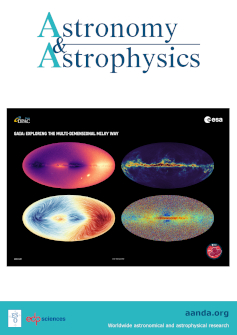Mon R2和M17 SW中的[O I]精细结构线剖面:通过[12C II]自吸收识别的冷前景物质的令人费解的性质
IF 5.4
2区 物理与天体物理
Q1 ASTRONOMY & ASTROPHYSICS
引用次数: 0
摘要
背景。最近对银河系恒星形成区[12C II]和[13C II]线剖面的光学深度比较研究发现,低激发前景物质对[12C II]有很强的自吸收作用。这意味着 C+ 的柱密度很高,相当于几个(最多约 10 个)马格的等效 AV 值。由于难以确定如此巨大的冷 C+ 前景气体柱的性质和来源,因此必须对这种物质的物理条件进行约束。我们对 M17 SW 和 Mon R2 的 [O I] 63 μm 和 [O I] 145 μm 线进行了高分辨率观测。145 μm 的[O I]转变追踪的是温暖的 PDR 物质,而 63 μm 的[O I]线追踪的是前景物质,具体表现为吸收倾角。将两条[O I]线剖面与[C II]同位素线进行比较,证实了源于温暖的 PDR 背景发射和大量的冷前景物质柱,从而导致在[12C II]和[O I] 63 μm剖面中可以看到自吸收。在 M17 SW 中,两层的 C+ 和 O0 柱密度相当。与 C+ 相比,Mon R2 的 O0 柱密度更大,表明碳是中性或分子形式的额外物质。前景吸收剖面的小尺度空间变化和前景物质的大柱密度(~1018 cm-2)表明,发射来自与云复合体相关的高密度区域,而不是均匀的弥漫前景云。分析证实,之前探测到的强烈[C II]前景吸收可归因于一个大的低激发致密原子物质柱,其中碳被电离,而氧处于中性原子形式。本文章由计算机程序翻译,如有差异,请以英文原文为准。
The [O I] fine structure line profiles in Mon R2 and M17 SW: The puzzling nature of cold foreground material identified by [12C II] self-absorption
Context. Recent studies of the optical depth comparing [12C II] and [13C II] line profiles in Galactic star-forming regions have revealed strong self-absorption in [12C II] by low excitation foreground material. This implies a high column density for C+, corresponding to equivalent AV values of a few (up to about 10) mag.Aims. As the nature and origin of such a great column of cold C+ foreground gas are difficult to determine, it is essential to constrain the physical conditions of this material.Methods. We conducted high-resolution observations of [O I] 63 μm and [O I] 145 μm lines in M17 SW and Mon R2. The [O I] 145 μm transition traces warm PDR-material, while the [O I] 63 μm line traces the foreground material, as manifested by the absorption dips.Results. A comparison of both [O I] line profiles with [C II] isotopic lines confirm warm PDR-origin background emission and a significant column of cold foreground material, causing the self-absorption to be visible in the [12C II] and [O I] 63 μm profiles. In M17 SW, the C+ and O0 column densities are comparable for both layers. Mon R2 exhibits larger O0 columns compared to C+, indicating additional material where the carbon is neutral or in molecular form. Small-scale spatial variations in the foreground absorption profiles and the large column density (~1018 cm−2) of the foreground material suggest the emission is coming from high-density regions associated with the cloud complex – and not a uniform diffuse foreground cloud.Conclusions. The analysis confirms that the previously detected intense [C II] foreground absorption is attributable to a large column of low-excitation dense atomic material, where carbon is ionized and oxygen is in a neutral atomic form.
求助全文
通过发布文献求助,成功后即可免费获取论文全文。
去求助
来源期刊

Astronomy & Astrophysics
地学天文-天文与天体物理
CiteScore
10.20
自引率
27.70%
发文量
2105
审稿时长
1-2 weeks
期刊介绍:
Astronomy & Astrophysics is an international Journal that publishes papers on all aspects of astronomy and astrophysics (theoretical, observational, and instrumental) independently of the techniques used to obtain the results.
 求助内容:
求助内容: 应助结果提醒方式:
应助结果提醒方式:


